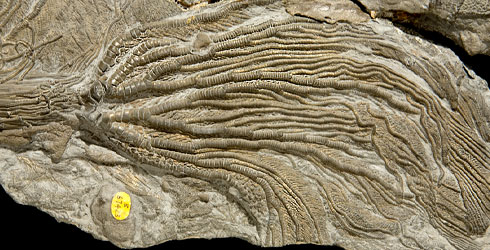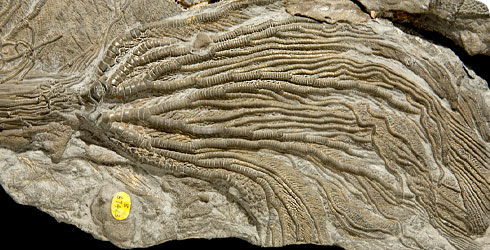Pentacrinites fossilis
This extinct crinoid is widely regarded as one of the most beautiful echinoderm fossils to be found in Britain. It is frequently found entirely preserved and covered in the mineral pyrite (fool’s gold) which gives the fossil a golden colour. The crinoid is composed of a long angular stem, a small body and long flowing feathery arms.
Species detail
This species is found in the Lower Jurassic limestones and shales around Lyme Regis and is about 190 million years old. Fossil Pentacrinites are not common however where they are found, they occur in great masses with many individuals overlying one another.
During the Jurassic this species lived in a warm tropical sea with many small islands and between two large land masses (similar to the Caribbean today).
-

Taxonomy
Learn about the form and structure of Pentacrinites fossilis, find out its distinguishing features and discover how it is thought to have evolved.
-

Distribution and habitat
Discover the areas where Pentacrinites fossilis is known from and the type of habitat it lived in. Find out population trends for this species as well as its feeding patterns.
-

Biology
Find out about the size and growth patterns of Pentacrinites fossilis as well as what is known about its lifecycle.
-

Behaviour
Discover what research has revealed about the life of Pentacrinites fossilis and how it is believed to have become fossilised.
-

Conservation
Find out the threats to Pentacrinites fossilis fossil sites and get tips for fossil hunting.
Images

Fossils of Pentacrinites fossils.

Pentacrinites fossils
Author
Dr Tim Ewin
Invertebrates Curator in the Palaeontology Department.
